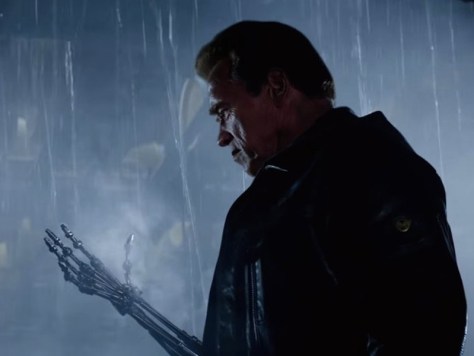
Terminator Genisys plays out like a crash course on how not to reboot an ailing franchise, as if the writers compiled a checklist of losing ideas and then proceed to sullenly tick off each box during its two-hour runtime. It is stunning the degree to which this film chooses to alienate both allegiant fans of the series, who will no doubt feel betrayed by the pandering attempts to “upgrade” storylines from the original movies, and attentive newcomers, who will no doubt be baffled by the ludicrously convoluted plotting. The persistent thought in my head while watching was “who is this movie for?” and I’m still not sure I have a good answer.
We start in Los Angeles 2029, with Human Resistance leader John Connor (Jason Clarke) and sergeant Kyle Reese (Jai Courtney) squaring off against the evil AI force Skynet. In events that mirror those of the first Terminator film, Skynet sends a Terminator back to 1984 to kill John’s mother Sarah (Emilia Clarke) to effectively negate his existence. To combat this, the Resistance sends Reese back to protect her but when he arrives in the past, he finds the circumstances to be radically altered as Sarah is far from helpless and has instead acquired another Terminator (Arnold Schwarzenegger) as an ally and confidant.
Bare in mind, I’ve only covered about the first twenty minutes there and if you’ve seen onslaught of marketing over the past few weeks, you’ll know that there are at least two or three other big plot reveals that I’ve chosen not to spoil here. Over the past few years or so, Hollywood has developed a worsening habit of giving away too much in trailers or TV spots in order to sell their movies and the promotion for Terminator Genisys may be the worst that I’ve seen so far. I accept that trailers are essential to selling a film and I even think they can be effective forms of mini-storytelling but it can’t be at the expense of ruining major plot points for potential moviegoers.
Despite this, I can’t say that I fully fault the poor saps at Paramount who were saddled with the insurmountable task of making this mess of a film look approachable. Of course the myriad callbacks to the original film are derivative and lazy but even the action sequences play out like rewarmed leftovers from better films, as when a school bus flips over front first à la the Joker’s 18-wheeler in The Dark Knight. At least there’s an attempt at a practical effect there, as the rest of the setpieces rely more on distractingly subpar CG effects that look much less convincing than those in the now 24-year old predecessor Terminator 2: Judgment Day.
That’s just one reason why that film works so much better than Terminator Genisys but Terminator 2 had another important aspect: it kept it simple. Once the characters and their motivations are established, the story progresses organically and at a reasonable pace. I gave up counting the number of times that characters in Genisys needed to stop and explain what was happening and even at that, plot holes and logical lapses crept up at a daunting rate. Even the best efforts of the charismatic Arnold Schwarzenegger can’t save this cumbersome and overcooked retread.










